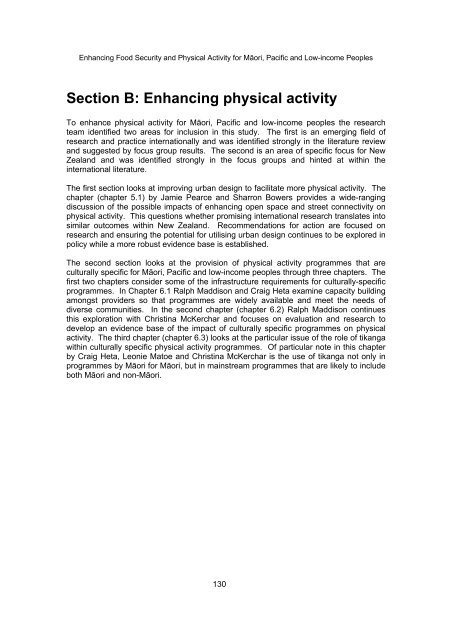enhancing food security and physical activity for maori, pacific and ...
enhancing food security and physical activity for maori, pacific and ...
enhancing food security and physical activity for maori, pacific and ...
- No tags were found...
Create successful ePaper yourself
Turn your PDF publications into a flip-book with our unique Google optimized e-Paper software.
Enhancing Food Security <strong>and</strong> Physical Activity <strong>for</strong> Māori, Pacific <strong>and</strong> Low-income PeoplesSection B: Enhancing <strong>physical</strong> <strong>activity</strong>To enhance <strong>physical</strong> <strong>activity</strong> <strong>for</strong> Māori, Pacific <strong>and</strong> low-income peoples the researchteam identified two areas <strong>for</strong> inclusion in this study. The first is an emerging field ofresearch <strong>and</strong> practice internationally <strong>and</strong> was identified strongly in the literature review<strong>and</strong> suggested by focus group results. The second is an area of specific focus <strong>for</strong> NewZeal<strong>and</strong> <strong>and</strong> was identified strongly in the focus groups <strong>and</strong> hinted at within theinternational literature.The first section looks at improving urban design to facilitate more <strong>physical</strong> <strong>activity</strong>. Thechapter (chapter 5.1) by Jamie Pearce <strong>and</strong> Sharron Bowers provides a wide-rangingdiscussion of the possible impacts of <strong>enhancing</strong> open space <strong>and</strong> street connectivity on<strong>physical</strong> <strong>activity</strong>. This questions whether promising international research translates intosimilar outcomes within New Zeal<strong>and</strong>. Recommendations <strong>for</strong> action are focused onresearch <strong>and</strong> ensuring the potential <strong>for</strong> utilising urban design continues to be explored inpolicy while a more robust evidence base is established.The second section looks at the provision of <strong>physical</strong> <strong>activity</strong> programmes that areculturally specific <strong>for</strong> Māori, Pacific <strong>and</strong> low-income peoples through three chapters. Thefirst two chapters consider some of the infrastructure requirements <strong>for</strong> culturally-specificprogrammes. In Chapter 6.1 Ralph Maddison <strong>and</strong> Craig Heta examine capacity buildingamongst providers so that programmes are widely available <strong>and</strong> meet the needs ofdiverse communities. In the second chapter (chapter 6.2) Ralph Maddison continuesthis exploration with Christina McKerchar <strong>and</strong> focuses on evaluation <strong>and</strong> research todevelop an evidence base of the impact of culturally specific programmes on <strong>physical</strong><strong>activity</strong>. The third chapter (chapter 6.3) looks at the particular issue of the role of tikangawithin culturally specific <strong>physical</strong> <strong>activity</strong> programmes. Of particular note in this chapterby Craig Heta, Leonie Matoe <strong>and</strong> Christina McKerchar is the use of tikanga not only inprogrammes by Māori <strong>for</strong> Māori, but in mainstream programmes that are likely to includeboth Māori <strong>and</strong> non-Māori.130
















